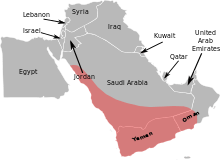Arabian cobra
The Arabian cobra (Naja arabica) is a species of venomous snake in the family Elapidae. The species is endemic to the Arabian Peninsula. the cobra within the peninsula is a concern, with having a major cause of mortality rate in the region. researchers recently had tested and made an antivenom to treat the lethal bite that it carries.<Moussa, I., Hessain, A., Al-Arfaj, A. Farouk, K., Selim, S. 2015. immunological Properties of Anti Naja haje arabica (The Arabian Cobra) Snake Venom Antibodies Prepared in Chicken 11: 956–959.>
| Arabian cobra | |
|---|---|
| Scientific classification | |
| Kingdom: | Animalia |
| Phylum: | Chordata |
| Class: | Reptilia |
| Order: | Squamata |
| Suborder: | Serpentes |
| Family: | Elapidae |
| Genus: | Naja |
| Species: | N. arabica |
| Binomial name | |
| Naja arabica (Scortecci, 1932) | |
 | |
| Range of Arabian cobra | |
| Synonyms[2] | |
| |
></ref>
Geographic range
The Arabian cobra is found in Oman, southern and western Saudi Arabia, and Yemen.[1]
Etymology
The specific name, arabica is Latin for Arabian.
Taxonomy
This species, Naja arabica, had long been considered a subspecies of the Egyptian cobra (Naja haje), but morphological and genetic differences have led to its recognition as a separate species.[3] N. arabica is an elusive species and rarely seen in the wild.
References
- Els J, Al Johany AMH (2012). "Naja arabica ". The IUCN Red List of Threatened Species. Version 2012.2. www.iucnredlist.org. Retrieved 10 January 2013.
- Species Naja arabica at The Reptile Database . www.reptile-database.org.
- Trape, Jean-François; Chirio, Laurent; Broadley, Donald G.; Wüster, Wolfgang (2009). "Phylogeography and systematic revision of the Egyptian cobra (Serpentes: Elapidae: Naja haje) species complex, with the description of a new species from West Africa" (PDF). Zootaxa. 2236: 1–25. Retrieved 9 February 2012.
Further reading
- Scortecci G (1932). "Rettili dello Yemen ". Atti della Società Italiana di Scienze Naturali e del Museo Civico di Storia Naturale in Milano 71: 39–49. (Naja haje arabica, new subspecies, pp. 47–49). (in Italian).
